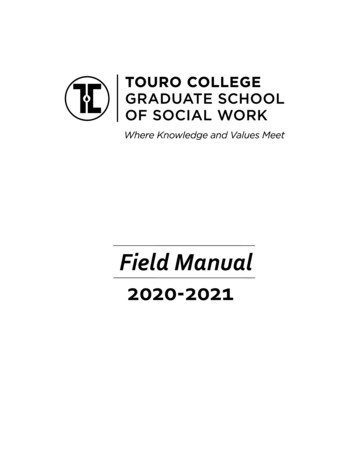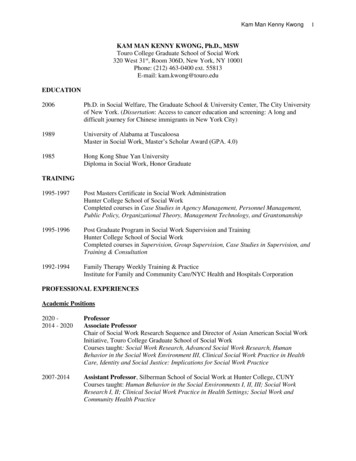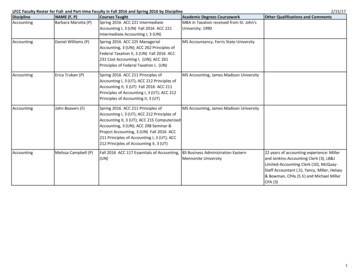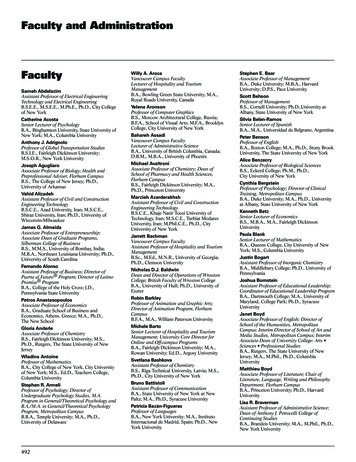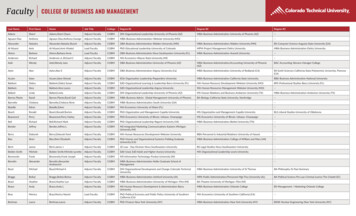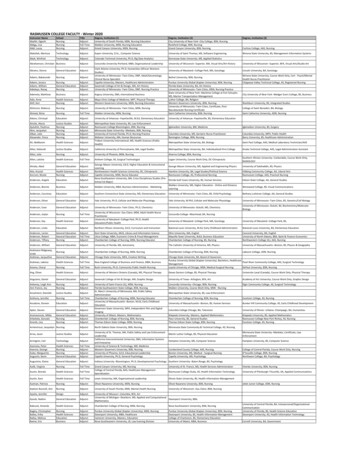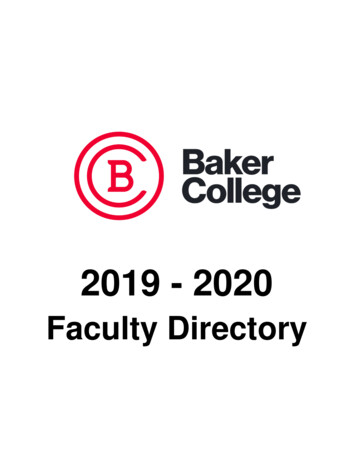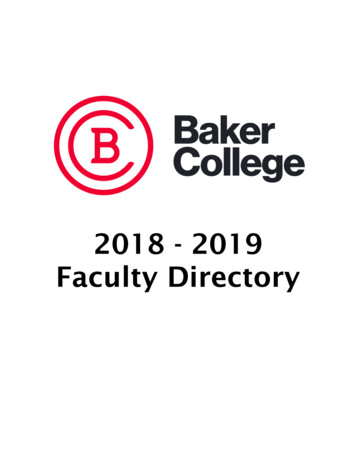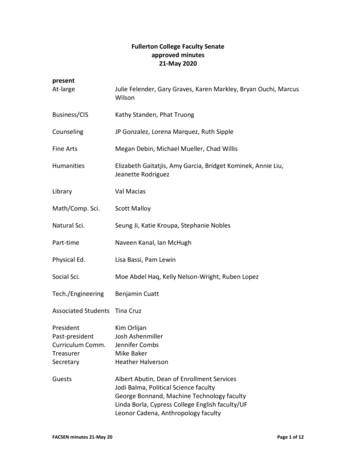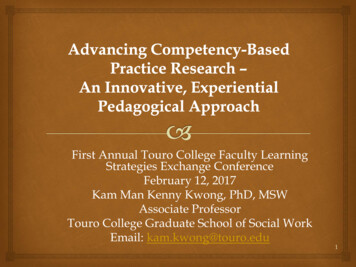
Transcription
First Annual Touro College Faculty LearningStrategies Exchange ConferenceFebruary 12, 2017Kam Man Kenny Kwong, PhD, MSWAssociate ProfessorTouro College Graduate School of Social WorkEmail: kam.kwong@touro.edu1
Background Achieving practice-based research competency is anessential pillar of social work practice. However,learning research has not been a favored subject insocial work education. The research content is often not taught from a socialwork practice orientation. Research is associated with dry lectures andincomprehensible statistics that may not reveal reallife circumstances.2
Background Teaching research course is often antithetical tothe pedagogical approach generally adopted insocial work education, which engages studentsin examples and practical applications of reallife situations.3
Focus of this Workshop Introduce a range of class and field activities in a 2semester social work research courses, including Case studies Storytelling Field surveys and interviews Critical reflection activitiesThese activities are designed to increase graduate levelsocial work students’ competencies of practice research.4
Strategies and Tools I will share a range of tools and strategies to help enhanceteaching effectiveness and evaluate the extent of students’attainment of practice research competencies. These toolsinclude: Use of guided discussion Interview questionnaire Assignment instructions Assessment rubrics5
Six Major Class Activities (1) Formulating a practice-based research topic – a casestudy(2) Using assessment templates for critical evaluation ofpublished research(3) Single subject research – a tool for evaluation ofclinical practice(4) Agency research capacity field assessment(5) Design and implementation of a practice-focused classstudy project(6) Class activity on presentation and dissemination ofresearch findings.6
1. Formulating a Practice-basedResearch Topic – A Case Study Case Study – Extracted from Yegidis & Weinbach (2002)Part 1Research Problem StatementDuring the past year child protection workers were receivingmany more reports of possible child abuse by localprofessionals than in previous years. A very large percentageof the cases were never opened for services because the workerassigned to investigate had determined that they wereunfounded. Form the agency perspective, there was a problemof inefficient use of worker’s time. They were spending muchof their day dealing with reports where no abuse had takenplace, while not having enough time to devote to those caseswhere abuse was probable. The problem was too manyunfounded cases.7
1. Formulating a Practice-basedResearch Topic – A Case Study Five Possible Research Problems Social workers might be taking too many inappropriate referrals. The social workers’ behavior might relate to their inadequatetraining. There might be too much missed child abuse by overworked childprotection workers (erroneous unfounded conclusions) There might be a tendency on the part of workers not to want tosee the existence of abuse that had occurred for fear that adetermination of founded cases would result in more work forstaff. Some workers might be more likely than others to perceive thatabuse had taken place.Class discussion - based on agency needs, practical and feasibility,and political considerations, which of the above research problemswill you select to pursue? Why?8
1. Formulating a Practice-basedResearch Topic – A Case Study Part 2Research Problem Selected from Part 1: Some workers might be morelikely than others to perceive that abuse had taken place.Research Questions What laws and regulations govern child protection workers’decisions about whether a case is determined to be founded?Could recent changes in reporting procedures somehow beaffecting whether a case is regarded as founded? Could different working conditions in some way help to explainthe different rates? Could differences in education and training of workers somehowrelate to the different rates? Do clients perceive that some workers are more conscientious intheir investigation than others? How great an influence is supervision in worker determinationsregarding reports of suspected abuse?9
1. Formulating a Practice-basedResearch Topic – A Case Study Are community professionals somehow influencing the decisionsof some workers more than others? If so, how is this occurring? Do some social workers perceive rewards for either founded orunfounded cases that other workers do not perceive? How might work experience of the child protection worker affectthe way that a case is perceived? Does burnout somehow contribute to the different rates of foundedcases among workers? Are the different demographic characteristics of workers (forexample, age, race, sex, or parenthood) related to theirdeterminations?Class discussion - which of the above research questions to pursue?Why? In what way we can combine some of these questions?Research question restated as: Are characteristics of workers relatedto their determinations of whether a case is judged to be founded?(Question 3, 7, 9, and 10)10
1. Formulating a Practice-basedResearch Topic – A Case StudyPart 3Research Problem StatementToo many unfounded cases of child abuse Research Problem SelectedSome workers might be more likely than others to perceive that abuse had takenplace.Research Questions SelectedAre characteristics of workers related to their determinations of whether a case isjudged to be founded? Are different demographic characteristics of workers (for example, age, race,sex, or parenthood) related to their determinations? Could differences in education and training of workers relate to the differentrates? Do some social workers perceive rewards for either founded or unfoundedcases that other workers do not perceive? Does burnout somehow contribute to the different rates of founded casesamong workers?11
1. Formulating a Practice-basedResearch Topic – A Case StudyDiscussion: How do we define staff characteristics? How to define staff determinations of whether a case isjudged to be founded or not? How to proceed with the literature review related tothis research question and variables?1. What keywords to use in database search?2. What sources of literature considered?3. Outline of the literature reviewed?12
2. Assessment Templates for CriticalEvaluation of Published Research Chart Summary of 10 Articles/Citing References usingAPA Citation StyleIn your literature review, search for 10 articles (at least 6scholarly, peer reviewed articles published in reputablejournals) that you think will provide you with criticalknowledge and understanding to your research topic andrelated questions.13
2. Assessment Templates for CriticalEvaluation of Published ResearchArticle 1 AuthorsArticle TitleYearJournal easures3Findings4Limitations514
2. Assessment Templates for CriticalEvaluation of Published Research Subjects - Who was being studied? What was thepopulation of interest? Methods – Was this a survey or experiment? Was this aquantitative study, qualitative study, or were mixedmethods used? How was study participants recruited? Measures - What was measured? Did the researcherdevelop the questions or a standardized measure wasused? Interview or self-report questionnaire? Findings - What are the main results? Limitations - What are the limitations discussed? Anyadditional limitations?15
2. Assessment Templates for CriticalEvaluation of Published Research For government statistical reports, policy/concept papers,book chapters, research reports, etc., you will summarize thefollowing from each of these reports:purpose of the paper/studywhat did the author(s) want to find out or present?What was/were the author(s) research question(s)?How was it/were they similar to or different from yourresearch question(s)? How did the authors study the research questions? What were the major findings of these studies and howthese findings informed your study? 16
2. Assessment Templates for CriticalEvaluation of Published Research Article Critique Assignment - Students are asked to applytheir critical thinking skills and knowledge to complete thisassignment. They select one of the three assigned articles tocritique by addressing the following questions: What was the research question (s)? Were there any study hypothesis/hypotheses? If yes, whatwere they? Briefly describe the study design (qualitative orquantitative, cross-sectional, longitudinal, quasiexperimental, experimental, etc.)? What was the population of interest? Who did they use as the study sample?17
2. Assessment Templates for CriticalEvaluation of Published Research What methods did they use to recruit/select their sample? Forexample, what type of sampling method did they use? Was itrandom or non-random sampling? What was their data collection technique (survey, interview,observation, chart reviews)? What did they use as study measures or data collectioninstruments? What were the key results/findings? What were the strengths of the study, either stated or in youropinion? What were the limitations of the study, either stated or in youropinion? What are the implications of the study findings, or future steps forresearch and/or practice? In your opinion, what was the overall quality of the article?18
3. Single Subject Research – a Toolfor Evaluation of Clinical Practice The purpose of this assignment is to increase student’sfamiliarity with the single subject design method and tobuild your confidence in your ability to use this type ofassessment in social work practice.Instructions for the Single Subject Research Project: You will be evaluating yourself or someone youknow in some manner for this project. Choose ONEtarget behavior/feeling/thought of the person thatyou will attempt to change. For example: cigarettesmoking, soda intake, checking Facebook, lateness,weight loss, etc.19
3. Single Subject Research – a Toolfor Evaluation of Clinical Practice Choose an intervention that will assist you in making thatchange Define the target behavior/feeling/thought that youattempt to change in measureable terms by creating twomeasurable indicators (can be measured by frequency,magnitude, or duration), e.g. ounces of soda in a day. Your indicator(s) must be specific enough to be measured,and can be measured frequently. Select a behavior orthought that has the potential to have a wide range ofvalues, not just if it happens or not (yes/no).20
3. Single Subject Research – a Toolfor Evaluation of Clinical Practice Create a graph with X and Y axes. The Y axis willmeasure your operationalized indicator for each attempt(what happened with that behavior/feeling/thought), theX axis will measure what day/trial this happened. I willcirculate an excel file for you to plot the graph. Take baseline measures for at least several days/times ofyour operationalized indicator. After baseline, implement an intervention that is aimed atchanging your target behavior/feeling/thought, andcontinue to measure it for at least 7-10 days to track thechanges.21
4. Agency Research and EvaluationField Assessment Class Discussion - What is my agency doing with data?What am I doing with this?Whether you are majored in clinical practice, group work,community organizing, administration, management, or anyspecialized field of practice (such as international social work,health or mental health, children, youth, and families, world ofwork, aging, etc.) we are constantly producing tons ofinformation such as assessment records, client information,program assessment, program evaluation, communityplanning session, process recording, discussion groupsfinding, client observation records, etc. regularly in ouremployment or internship.22
4. Agency Research andEvaluation Field Assessment What kinds of data does the agency generally do to collect,manage, classify/organize? How does your agency summarizeand present the data and in what formats? What functions dothese activities serve? Who primarily perform those functions? What tools does your agency use to manage and analyze data? Dothey use any tools such as access, excel, statistical or othersoftware to help with these functions? What roles and functions do you play with data (collect data only,manage data, or summarize data)? What do you perceive as important advantages/benefits to have(or create) a sound data collection, management, and analysissystems in the agency? What are the constraints that prevent theagency from doing so?23
4. Agency Research andEvaluation Field AssessmentA short essay – Consult or interview your agencysupervisor or someone in your agency whois primarily handling data and reports toaddress the above questions. Write a briefreport on what you have found andprovide examples.24
5. Design and Implementation of APractice-focused Class Study Project Class discussion and select a group study project to exploreperceptions and attitudes about terrorism and governmentmonitoring program among general publicBest, S. J., Krueger, B. S., & Pearson-Merkowitz, S. (2012). AlQaeda versus Big Brother: Anxiety about governmentmonitoring and support for domestic counterterrorismpolicies. Political Behavior, 34, 607-625.Cohen, P. et al. (2006). Current affairs and the publicpsyche: American anxiety in the post 9/11 world. SocialPsychiatry and Psychiatric Epidemiology, 41, 251–26025
5. Design and Implementation of APractice-focused Class Study Project Instruction to Potential ParticipantsI am a student at the Touro College Graduate School ofSocial work and I am collecting data regarding perceptionsand attitudes about terrorism and government monitoringprogram among general public for a class research project.There is no right or wrong answers. We are interested inyour true opinions. Please do not put your name on thissurvey to maintain anonymity. Your completed survey willjoin hundreds of other anonymous surveys that we willcollect to complete analysis and prepare a class report.26
6. Class Activity - Presentation &Dissemination of Research Findings You completed the perceptions and attitudes about terrorismand government monitoring program study with about 180community members in New York City. You compiled thedemographic profiles of these participants and assessed theirperception, attitude, and feelings on terrorism andgovernment monitoring activities. You had interestingfindings about relationships between certain demographiccharacteristics of these participants such as their educationallevel, racial or ethnic background, immigration status, familybackground, etc. with their attitude, perceptions, andknowledge towards terrorism.In a small group, you will discuss either Q1 and2 or Q3 and 4in 20 minutes and then report the summary of your discussionin the class.27
6. Class Activity - Presentation &Dissemination of Research Findings Q1 Your research team would like to publish this studyin a professional journal, what would you plan to do toprepare the paper, what else you need to know tostrengthen the paper that can be potentially publishable? Q2 You are invited to give a presentation for 30 minutesat a national psychology conference on terrorism, health,and mental health issues. Participants include mainlyresearchers, government and non-profit agencyexecutives, health and mental health administrators, andseasoned practitioners. How will you prepare thepresentation?28
6. Class Activity - Presentation &Dissemination of Research Findings Q3 You are invited to conduct a presentation of your study in aregional interdisciplinary event with about 50 participants. The 1hour workshop format will allow more instant and interactivedialogues between presenters and participants who are mainlypractitioners from different disciplines including physicians,social workers, guidance counselors, psychologist, public healthprofessionals, teachers, community advocates, paraprofessionals,etc. What is your plan to facilitate this workshop to share thefindings of your study? Q4 Terrorism and national security is a hot topic recentlybecause of terrorist attack in Paris. A local media reporterlearned about your study and would like to conduct an interviewwith you and hopefully write an article about your study in amajor newspaper. What would you need to know to prepare forthe interview and what is your plan to share the findings of yourstudy?29
Discussion Key Elements of An Innovative, ExperientialPedagogical Approach It is a case-based learning and through examples andrich case descriptions, students learn about realworld research issues. It is discussion-centered and research ideas flowsfluidly between professor and students.30
Discussion Key Elements of An Innovative, ExperientialPedagogical Approach It is a collaborative learning process as studentsactively discuss about their practice cases they arestudying and engage in constructive dialogues witheach other. Finally cases chosen for learning and research arecontext-specific as students see the connection ofsocial work research to day-to-day practice contexts.31
Thank You! Questions? Comments?32
First Annual Touro College Faculty Learning Strategies Exchange Conference February 12, 2017 Kam Man Kenny Kwong, PhD, MSW Associate Professor Touro College Graduate School of Social Work Email: kam.kwong@touro
